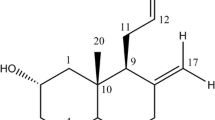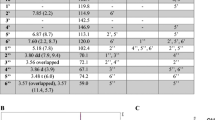Summary
The mechanism of action of bucillamine, [N-(2-mercapto-2-methylpropionyl)-l-cysteine] (BC), a novel antirheumatic drug that is used in patients with rheumatoid arthritis (RA), was compared with that of d-penicillamine (DP). BC inhibited phytohemagglutinin (PHA)-induced DNA synthesis of peripheral blood mononuclear cells (PBMCs) in a dose-dependent manner, and this inhibition occurred both in the presence and absence of copper, whereas DP-induced inhibition required the presence of cupric ions. Significant inhibition of DNA synthesis was observed at a BC concentration of 10 μg/ml. The disulfide form of BC, but not DP disulfide, suppressed the proliferation of PBMCs. After preincubation of human peripheral blood T lymphocytes or Møs with BC or DP, these cells were combined and the overall PHA response was estimated. Inhibition of the PHA response was observed following pretreatment of either T lymphocytes or Møs with BC, whereas inhibition was attained only when T lymphocytes were pretreated with DP and copper. As sulfhydryl agents produce hydrogen peroxide in the presence of cupric ions, the effect of catalase on DP- and BC-induced inhibition of PBMC DNA synthesis was examined. Catalase partially reversed the BC-induced inhibition of DNA synthesis of PBMCs, and it restored the inhibition by DP and copper almost to the control level. These results suggest that BC suppresses the function of both T lymphocytes and Møs in the mitogen response of PBMCs, whereas the action of DP is targeted at T lymphocytes.
Similar content being viewed by others
References
Kashiwazaki S, Shiokawa Y (1987) Bucillamine: a new immunomodulator. Int J Immunother 3:1–6
Matsubara T, Saura R, Hirohata K, Ziff M (1989) Inhibition of human endothelial cell proliferation in vitro and neovascularization in vivo by d-penicillamine. J Clin Invest 83:158–167
Matsubara T, Hirohata K (1988) Suppression of human fibroblast proliferation by d-penicillamine and copper sulfate in vitro. Arthritis Rheum 31:964–972
Lipsky PE, Ziff M (1978) The effect of d-penicillamine on mitogen-induced human lymphocyte proliferation: synergistic inhibition by d-penicillamine and copper salts. J Immunol 120:1006–1013
Lipsky PE, Ziff M (1980) Inhibition of human helper T cell function in vitro by d-penicillamine and CuSO4. J Clin Invest 65:1069–1076
Lipsky PE (1984) Immunosuppression by d-penicillamine in vitro. Inhibition of human T lymphocyte proliferation by copper-or ceruloplasm-dependent generation of hydrogen peroxide and protection by monocytes. J Clin Invest 73:53–65
Nakata K, Suda H, Yamauchi H, Iso T (1985) Pharmacological studies of N-(2-mercapto-2-methylpropanoyl)-l-cystein (SA96). 3. Effect of SA96 on experimental allergic reactions. Jpn J Pharmacol 37:85–90
Fujimura H, Hiramatsu Y, Tamura Y, Yanagihara M, Koda A, Nagai H, Udo K, Iso T, Yamauchi H (1980) Pharmacological studies of new sulfhydryl compounds 2-mercapto-2-methyl-propanoyl-l-cysteine (in Japanese). Folia Pharmacol Japon 76:117–129
Kosaka S, Itoh K, Kumagai K (1983) An in-vitro study of SA-96 (DE-019), an immunomodulator, and its application in the treatment of rheumatoid arthritis (in Japanese). Tohoku J Med 96:13–21
Boveris A, Martino E, Stoppani AOM (1977) Evaluation of the horseradish peroxidase-scopoletin method for the measurement of hydrogen peroxide formation in biological systems. Anal Biochem 80:145–158
Corbett JT (1989) The scopoletin assay for hydrogen peroxide. A review and a better method. J Biochem Biophys Methods 18:297–308
Starkebaum G, Root RK (1985) d-penicillamine: analysis of the mechanism of copper-catalyzed hydrogen peroxide generation. J Immunol 134:3371–3378
Boyum A (1968) Isolation of mononuclear cells and granulocytes from human blood: isolation of mononuclear cells by one centrifugation, and of granulocytes by combining centrifugation and sedimentation at 1 g. Scand J Clin Lab Invest [Suppl] 21:77–89
Galili U, Schlesinger M (1974) The formation of stable E rosettes after neuraminidase treatment of either human peripheral blood lymphocytes or of sheep red blood cells. J Immunol 112:1628–1634
Rosenberg SA, Lipsky PE (1979) Monocyte dependence of pokeweed mitogen-induced differentiation of immunoglobulinsecreting cells from human peripheral blood mononuclear cells. J Immunol 122:926–931
Mita S, Matsunaga K (1990) Differences in the effects of the anti-rheumatic drugs, bucillamine and d-penicillamine, on mitogen-induced proliferation of mouse spleen cells. Agents Actions 30:363–368
Gopalakrishna R, Anderson WB (1987) Susceptibility of protein kinase C to oxidative inactivation: loss of both phosphotransferase activity and phorbol diester binding. FEBS Lett 225:233–237
Tien M, Bucher JR, Aust SD (1982) Thiol-dependent lipid oxidation. Biochem Biophys Res Commun 107:279–285
Hyslop PA, Hinshaw DB, Hasley WA Jr, Schraufstatter IU, Spragg RG, Jackson JH, Cochrane CG (1988) Mechanisms of oxidant-mediated cell injury: the glycolytic and mitochondrial pathways of ADP phosphorylation are major intracellular targets inactivated by hydrogen peroxide. J Biol Chem 263:1665–1675
Backer MS, Feigan J, Lowther DA (1989) The mechanism of chondrocyte hydrogen peroxide damage: depletion of intracellular ATP due to suppression of glycolysis caused by oxidation of glyceraldehyde-3-phosphate dehydrogenase. J Rheumatol 16:7–14
Author information
Authors and Affiliations
Rights and permissions
About this article
Cite this article
Akamatsu, T., Matsubara, T., Saegusa, Y. et al. Inhibition of mitogen-induced response of human peripheral blood mononuclear cells by bucillamine, a new antirheumatic sulfhydryl drug. Rheumatol Int 13, 197–201 (1994). https://doi.org/10.1007/BF00390267
Received:
Accepted:
Issue Date:
DOI: https://doi.org/10.1007/BF00390267




